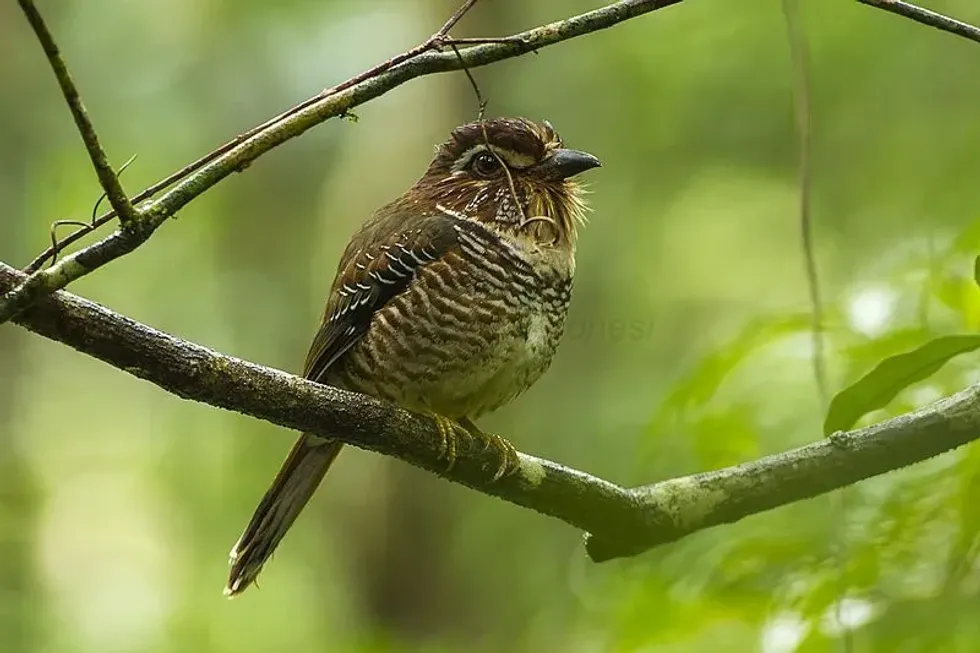Ground rollers are a group of five different species that make up the Brachypteraciidae family. They are all endemic to the island country of Madagascar.
They are mostly observed foraging on the ground.
They also lay their eggs in burrows on the ground except for the short-legged ground roller which nests in tree cavities. All the ground roller species favor the eastern rainforest regions except for the long-tailed ground roller (Uratelornis chimaera) which favors the thick scrubs of the sub-arid regions.
The ground rollers are very colorful and beautiful birds. They are known for their common 'boob' and 'whoop' calls which makes them easy targets for hunters.
They are also threatened by the introduction of black rats in their habitat as well as dogs and snakes.
There used to be a sixth species called the Ampoza ground roller which is now extinct because of changing habitats, the same threat faced by the species alive today. According to the IUCN, the pitta-like ground roller is a species of Least Concern, the rufous-headed ground roller is Near Threatened, and the other three species are all Vulnerable.
For more relatable content, check out these Meyer's parrot facts and common kingfisher facts for kids.
Ground Roller Interesting Facts
What type of animal is a ground roller?
A ground roller is a bird.
What class of animal does a ground roller belong to?
The ground roller (Brachypteraciidae) family belongs to the Aves class of animals.
How many ground rollers are there in the world?
There are 1,500-7,000 individuals of the scaly ground roller species, 7,800-19,600 individuals of the short-legged ground roller species, and 9,487-32,687 individuals of the long-tailed ground roller (Uratelornis chimaera) species left in the world. The exact number of rufous-headed ground roller and long-tailed ground roller birds left in the world is unknown.
Where does a ground roller live?
All the five ground roller species are native only to the island of Madagascar.
Long-tailed ground rollers (Uratelornis chimaera) are found in the southwest coastal areas of the country and between the Mangoky and Fiherenana rivers
The pitta-like ground roller is seen in the eastern parts of the island, from the extreme north to the far south, but also in the central high plateau and the northwest.
The rufous-headed ground roller (Atelornis pittoides) bird is found in eastern Madagascar, from the northeast to the south.
The scaly ground roller bird is also found in eastern Madagascar from the Andohahela in the south to Marojejy in the North.
The short-legged ground roller bird is also seen in eastern parts, from Andohahela Park in the south to Tsaratanana massif and Daraina in the north. It is also seen in the northwest parts near the coasts and at the end of the central plateau.
What is a ground roller's habitat?
Four out of the five ground roller bird species (except the long-tailed ground roller) live in the eastern rainforest of Madagascar near the water. The long-tailed ground roller (Uratelornis chimaera) is found in the sub-arid areas and thorny scrubs as well as deciduous woodlands up to elevations of 329 ft (100 m).
The other four species are found under sea levels of 5,250 ft (1,600 m).
Who do ground rollers live with?
Ground rollers are mostly shy, solitary birds. They are seen in pairs in the breeding season, and also in small family groups sometimes.
How long does a ground roller live?
It is unclear how long a ground roller lives, but it has a generation length of 5.6 years.
How do they reproduce?
Ground rollers reproduce by mating and laying eggs.
They form solitary, monogamous pairs in the breeding season, which is from September-February. They become territorial and are known to give advertising calls.
The short-legged ground rollers, the long-tailed ground rollers, and the scaly ground rollers are known to perform courtship displays. Nests are in burrows on steep grounds under vegetation, except for the long-tailed ground roller (Uratelornis chimaera) which excavates solidated sand instead.
One to four white eggs are laid around December and incubated in chambers in the burrows which have a soft lining. Only the short-legged ground roller nests in the cavities of trees. Incubation lasts for 18-26 days, mostly performed by the female, with the male presumably handling the feeding duties.
The chicks get their feathers about a week after hatching and are fed by each parent. The chicks fledge after 18 days or one month in the case of the short-legged ground roller.
What is their conservation status?
According to the International Union for Conservation of Nature, the scaly ground roller, the short-legged ground roller, and the long-tailed ground roller (Uratelornis chimaera) are Vulnerable species, the pitta-like ground roller is a species of Least Concern, and the rufous-headed ground roller is a Near Threatened species.
Ground Roller Fun Facts
What do ground rollers look like?
The five species of ground rollers are beautiful and have a variety of colors. They have cryptic-colored upperparts and are mostly bronzy-green and brown colors. The outer rectrices, flight feathers, and head are brightly colored.
They also have strong and long legs and a stout, small body. They also have zygodactylous feet and legs which are evidence of their territorial characteristics.
Their bills are stout, wings are rounded, and they have slit-like nostrils at the base with long bristles around them. The tongues of ground rollers have brush-like tips which help them in catching their favored small prey, insects. They all have long tails.
The pitta-like ground roller is probably the most striking of all five birds, with its white bib and bright blue head. The rufous-headed ground roller has bright rufous plumage and a white and black throat. The scaly ground roller has an overall finely scaled plumage.
Ground rollers have a range of colors on their bodies like sandy-buff, brown, black, blue, green, rufous, white, pink, olive, purple, violet, and yellow.

How cute are they?
Ground rollers are majestically beautiful animals. They are slightly duller than true rollers but that doesn't take anything away from their beauty.
All five species have a variety of colors on them and they have gorgeous long tails as well. The pitta-like ground roller is the standout roller when it comes to cuteness, with its white bib and blue head.
How do they communicate?
Ground rollers communicate via calls. Their territorial calls carry far and often come before sunrise.
Apart from the long-tailed ground roller (Uratelornis chimaera), these birds use low, guttural, and resonant calls in series that sound like 'boob' or 'whoop'. The long-tailed ground roller's call is a soft 'boobooboo' or a chuckling 'too-tuc too-tuc too-tuc' notes, heard before sunrise, at late afternoon, or even at night.
The territorial neighbor birds are known to indulge in countersinging. There are softer breeding and courtship calls and harsher alarm calls. The alarm calls are hissing sounds that sound like 'kwish-sh' or louder 'tac tac tashhhhhhhhhrr'. These birds call when excited as well.
How big is a ground roller?
When considering all the ground roller species, the range of their length is 9.5-19.3 in (24-49 cm), which makes them two to four times bigger than verdins.
How fast can a ground roller move?
It is not clear how fast ground rollers move on the ground, but considering other mostly ground-dwelling birds, they may move at speeds close to 5 mph (8 kph). And since they are medium-sized birds, they may move at 25 mph (40 kph).
How much does a ground roller weigh?
A ground roller weighs 2.6-7.7 oz (73-217 g).
What are the male and female names of the species?
The males and females of the ground roller species may be called cocks and hens respectively.
What would you call a baby ground roller?
A baby ground roller may be called a chick.
What do they eat?
Ground rollers feed on insects, reptiles, frogs, ants, butterflies, cockroaches, worms, beetles, chameleons, wasps, moths, earthworms, crickets, snails, spiders, lizards, cicadas, flies, mantises, and stick insects.
They themselves get preyed on by black rats, snakes, and dogs.
Are they dangerous?
No, ground rollers are not dangerous.
Would they make a good pet?
No, ground rollers would not make good pets. They are wild birds that need considerable territory to thrive and survive. Efforts should be made to conserve them and their habitat.
Did you know...
Atelornithidae is another name for the Brachypteraciidae family of ground rollers.
Do ground rollers migrate?
No, ground rollers are not migratory.
Different types of ground roller
There are five different ground roller species, short-legged ground roller, scaly ground roller, long-tailed ground roller, pitta-like ground roller, and rufous-headed ground roller. There was possibly a sixth species that is now extinct called the Ampoza ground roller.
Here at Kidadl, we have carefully created lots of interesting family-friendly animal facts for everyone to discover! Learn more about some other birds from our Inca dove facts and western kingbird fun facts pages.
You can even occupy yourself at home by coloring in one of our free printable ground roller coloring pages.









